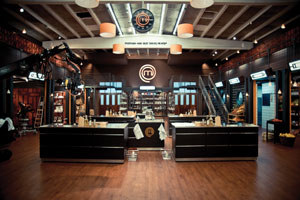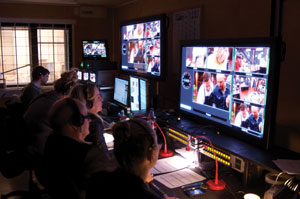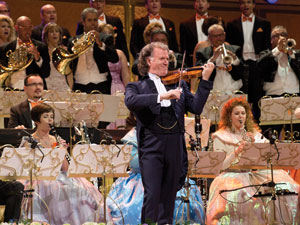Capturing viewers with studio production
Capturing and keeping viewers’ attention is the key to the commercial success and longevity of any broadcast production. This is especially true of the live entertainment environment, where a raft of game shows, talk shows and live entertainment programs are all striving to keep their viewers. In addition, shows can be cancelled with little notice if they fail to deliver, which creates a high-pressure environment and means studio workflows need to be able to mold to different productions’ needs in a flash. Flexibility is, therefore, a pre-requisite in any multi-camera studio production workflow.
In such an undulating and often unpredictable landscape, it can understandably become a bit of a balancing act; on the one hand, studios need to deliver ever-higher-quality-content and production values, yet on the other, they need to remain highly productive and flexible. The simple fact of the matter is both hands need to come together and join harmoniously to deliver on all of these elements, or risk a disjointed and unsuccessful production.
For example, the proliferation of high-quality talk shows, particularly in the U.S., requires a large and complex setup with delay functions, as well as live editing for fast turnaround. They also have to be interoperable with various other tools to handle file ingest and post-production to ensure a high-end playout, fast. This level of workflow complexity is fast becoming a standard studio expectation, across every type of production.
Complexity can constrain creativity. However, this very shift leaves broadcasters with something of a conundrum; the need for more complexity means a more time-consuming production process, which in turn limits the scope for creativity — the very thing that will provide differentiation in a crowded and often cutthroat marketplace.

Metronome Productions shoots “MasterChef” as a fast-turnaround, multi-camera production on this studio set at Studios A/S in Denmark.
It’s no secret that the consumer’s appetite is becoming increasingly ferocious, and that’s true of all types of production. Studios have to make sure consumers don’t go hungry by providing high-quality, speed and increased complexity of their program in terms of editing, graphics and interactivity with presenters and/or end users.
Another issue facing studios is the need to be much more flexible than in the past, due to a much more competitive landscape in entertainment production. If a show isn’t successful in its first few weeks, then studios are often faced with the dilemma of amending it, lest the production gets scrapped altogether. And so studios need a technical setup comprised of equipment that’s easily available on the market and also easily understood so they can quickly and easily access what they need to adapt it.
However, the nature of studio production also means that they can be working on multiple productions that are completely separate and come with completely different requirements. That can be a real challenge. Productions need a system that can cope with, say, XDCAM in the week and a totally different codec during the weekend.
One thing we’re going to see a lot more of is situations in which a single studio is used for multiple productions, meaning the need to balance speed, adaptability and highly creative values really comes to the fore. The crucial thing is to ensure fast turnaround — from multi-cam ingest through to editing, post production and playout — in order to help the studio to stay one step ahead of the game, as well as allowing more time for creative teams to do what they do best — be creative — instead of spending all their time carrying out regular production processes. Tape-based workflows simply can’t handle that type of responsiveness.
Studios A/S
Studios A/S is a full-service facility provider in Denmark that’s home to TV shows such as “Strictly Come Dancing,” “Who Wants to be a Millionaire,” “Allstars,” “Luxury Trap” and “MasterChef.” It was tasked with helping Metronome Productions with the production of “MasterChef” and Snowman Productions with its production of “My Man Can.” Both companies were looking for a new way of delivering their shows quickly, efficiently and reliably, without stretching budgets further as they were with their current tape and disk-based workflows.

The action captured on Studios A/S production “MasterChef” is recorded direct to EVS servers. Shown here is the “MasterChef” production control room.
With “MasterChef,” Metronome Productions needed to produce 44 episodes of 50 minutes each. The team also had to record one master feed and five output ISO streams, as well as finish Season One filming in two and a half months.
“My Man Can” was different. Snowman Productions had to produce 24 episodes in just three weeks. Like Metronome, Snowman Productions needed a different approach to successfully produce the show within the tight timeframe.
Despite having different workflow requirements, they did share one major challenge: the need to find a more flexible workflow suitable for fast-turnaround multi-camera TV production. Both production companies used tape- and disk-based workflows like XDCAM, which meant high costs for tape machine hire, disks and manpower to operate the equipment. So the first hurdle was to overcome legacy workflows while reducing operating expenses.

Globomedia shot this fast-paced production of the Spanish drama “Lex” with Steadicam and direct-to-disk camera capture.
For a lot of production companies, like Metronome, producing shows in smaller countries means even more challenges — smaller viewer numbers and, therefore, tighter production budgets. It can be a real challenge for studios to cut costs without reducing production and playout quality or compromising on reliability. Adapting to using a new type of workflow, without much time to become accustomed to it, also presents its own challenges. Metronome’s workflow had always been linear: It would simply execute previously learned workflows and procedures. It wasn’t easy to change its approach from the way it’d always been done, and to transition to new methods and techniques. It had to be confident in these new ways of working.
Studio productions also need to be ready to cope with geographical challenges. For “My Man Can,” Snowman Productions was tasked with producing and delivering three seasons in three weeks to three different countries. This meant it needed to produce and deliver episodes a lot faster. But with hours of material, this was extremely difficult. The client also wanted the clips/rushes available for download over the Internet — something Studios A/S hadn’t done before.
To cater to this high degree of flexibility, studios will greatly benefit from selecting the same technology for each production — technology that can deliver all the necessary functionality, scalability and reliability, despite the different workflow requirements. It means they don’t need to look at different vendor options and offer value-added benefits for production companies by reducing overheads and providing a speedier workflow.
Studios should also consider the installation and support provided by the vendor, as getting that right can mean easy channel configuration, native support of multiple codecs and a multi-cam ingest server that can also be used for playout — saving more time and money. Third-party integration is also extremely important, so the entire production infrastructure knits together seamlessly, and everything from ingest to editing and playout flows together smoothly.
As we’re seeing, the challenges facing studios are numerous and, of course, the flexibility isn’t just necessary for the multiple-production scenarios. Often people associate studio production with the need for fast turnaround; however, it’s not the be all and end all. Like sports, entertainment shows need a workflow that’s flexible enough to cope with scalability, too.
Production overhaul
EVS technology was also deployed for a studio project for André Rieu, the Dutch violinist, conductor and composer, who’s one of the bestselling top-ten performers in the world. This project, like many studio projects, didn’t work to the same tight deadlines as fast-turnaround, multi-camera TV productions, but it did involve a much larger-scale undertaking, which is often the other situation studios find themselves in. In cases such as this, where studios might only have to produce a few shows a year — four, in the case of André Rieu , the team uses anywhere between 24 and 28 cameras for every show recorded. What’s more, the concert is usually recorded three times to ensure the best results.
Cost of tape
Using HDCAM VTRs to ingest the recorded material at its studio, André Rieu Studios needed two tapes for every camera it used. This left it with a resource-heavy and incredibly expensive workflow, in which it was paying for more than 575 tapes every year for the four annual shows it had to record and produce.
The tape-based workflow also left the team with HDCAM image quality, which gave it an extra generation loss due to the lower resolution HDCAM writes on the tape. The other cost factor was that it took three days to ingest all of the material once the tapes arrived at the studio. They were bulky to set up, and the process required more operators, which increased the costs further still.

Studios A/S handled another unique production challenge — the concerts of Dutch violionist André Rieu. This involved four shows a year using anywhere between 24 and 28 cameras for every show recorded. Each concert is usually recorded three times, for a resource-heavy workflow.
After a complete workflow overhaul, the studio is now working much more effectively. Although material ingested from the aging HDCAM VTR suffers a generation loss, the show is now recorded natively at HD-quality 1080i with DNxHD 120 codec files. This offers a much better image quality and vastly improves the results for the audience. Once the production process is complete, the shows are archived and stored on LTO tapes. This boost in performance and flexibility has enabled the studio to save time and money, and has also helped create a resource-light solution. The numerous studios across the globe that are in a similar situation to the André Rieu studios need to be looking for something more compact, scalable and cost-efficient.
It is abundantly clear that studios face many challenges when it comes to their production workflow, but the same is true across all markets. The ‘André Rieu’ situation isn’t unusual, and there are still many studios that are burdened with cumbersome and costly workflows: Third-party integration, easy installation and future-proofing are all pivotal here, and, indeed, in every studio scenario. Studios need to keep up with consumers’ increasing demands, and in order to do that most effectively, it all comes down to making time for that creative flair to do the talking. And the way to do that boils down to revising their production workflow and facing up to a little bit of short-term inconvenience for real long-term gains.
The sooner studios get the best production workflow in place, the sooner they’ll save the time and money they need to invest in the creativity. At the end of the day, that’s what’s going to allow them to overtake their competitors.
—Henry Alexander is SVP, Entertainment and News Division, at EVS.
Get the TV Tech Newsletter
The professional video industry's #1 source for news, trends and product and tech information. Sign up below.
